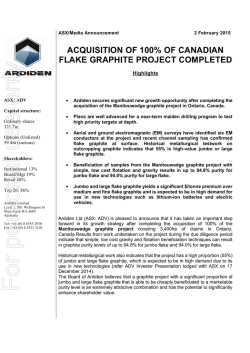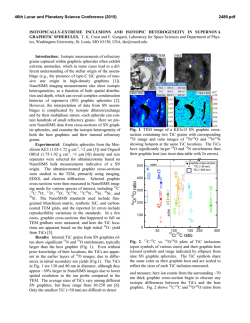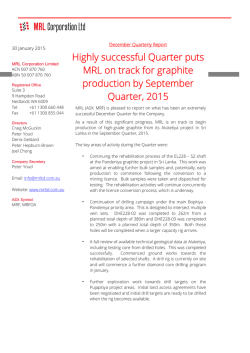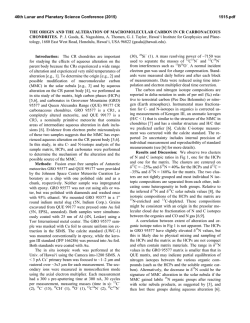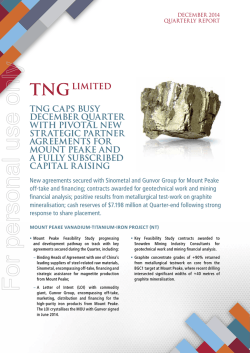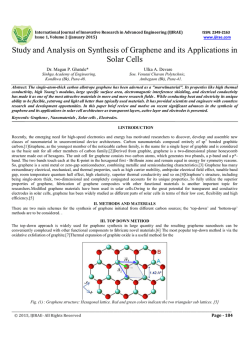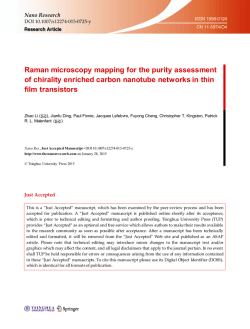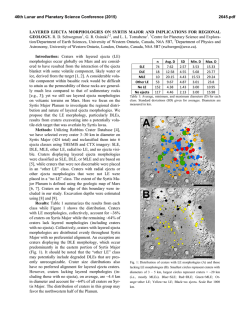
Graphite Morphologies in the Volcanic- Hosted Deposit at
macla nº 9. septiembre ‘08 revista de la sociedad española de mineralogía 91 Graphite Morphologies in the VolcanicHosted Deposit at Borrowdale (NW England, UK): Preliminary Raman and SIMS data / JOSÉ FERNÁNDEZ BARRENECHEA (1, *), JAVIER LUQUE (1), LORENA ORTEGA (1), MAGDALENA RODAS (1), DAVID MILLWARD (2), OLIVIER BEYSSAC (3) (1) Dpto. Cristalografía y Mineralogía, Facultad de Geología, Universidad Complutense de Madrid, 28040 Madrid ( Spain) (2) British Geological Survey, Murchison House, West Mains Road, Edinburgh EH9 3LA (UK) (3) Laboratoire de Geologie, CNRS-UMR 8538, Ecole Normale Supérieure, 24 rue Lhomond, 75231 Paris Cedex 5 (France) INTRODUCTION. Graphite structure consists of a continuous bidimensional array of sixfold rings of carbon atoms stacked along the c-axis. This determines that crystals commonly show laminar (platy) habits. In spite of this, other morphologies have been reported, but the widest range of morphologies known within a single paragenesis is reported here from the Borrowdale graphite deposit in Cumbria, UK. There, graphite mineralization is hosted within volcanic rocks, one of only two examples of such an association known worldwide. The crystal morphology of any mineral is controlled by both its structure and the physicochemical conditions prevailing during nucleation and growth. On the other hand, some geochemical features are also dependent upon the conditions of crystal growth. Thus, the structural and isotopic characterization of the graphite morphologies in the volcanic-hosted deposit at Borrowdale could help unravel the evolution of the mineralizing process in this particular environment. GEOLOGICAL SETTING MINERALOGICAL FEATURES. AND The Borrowdale graphite deposit consists of mineralized faults hosted by andesite lavas and sills belonging to the upper Ordovician (Caradoc) Borrowdale Volcanic Group, the geochemical characteristics of which show evidence of assimilation of pelitic material from the underlying Skiddaw Group (McConnell et al., 2002). The richest graphite deposits are developed at the intersections of the faults within steeply inclined pipe-like bodies up to 1 x 3 m in over 100 m in length. The pipe-like bodies contain nodular masses and patches of graphite, typically 1-2 cm across, but ranging from a few millimetres to 1 m or more. The mineral association of the deposit includes graphite, chlorite, epidote, and quartz. The study of fluid inclusions within quartz associated with graphite indicates that the mineralizing fluids evolved from H2O-CO2-CH4 mixtures (X H2O = 0.646; X CO2 = 0.244; X CH4 = 0.114; X NaCl = 0.006) to H2O-CH4 (X H2O = 0.93; X CH4 = 0.02; X NaCl = 0.05) fluids. The wide diversity of graphite morphologies recognized within the deposit can be grouped into three categories: laminar, cryptocrystalline, and spherulitic. Laminar graphite crystals (up to 300 µm long and 50 µm wide) are by far the most abundant (≈ 90%). Along fault zones, “graphic-like” intergrowth textures, consisting of thin curved and tapering graphite flakes or “vermiform” graphite crystals within chlorite have been observed. Cryptocrystalline graphite may form: 1) “composite nodules” consisting of both flaky and cryptocrystalline graphite, 2) rounded patches within flaky graphite, and 3) “colloform” bands and globules dispersed within the host rock. Spherulites occur in four different settings: 1) as individual forms, 5-40 µm in diameter, within flaky graphite, 2) as individual forms, 1-3 µm in diameter, included in quartz fragments, 3) as individual forms, 1-5 µm in diameter, or aggregates disseminated within the volcanic rock, and 4) as aggregates, 510 µm in diameter, associated with chlorite along fault zones. palabras clave: Grafito, Raman, SIMS, Borrowdale resumen SEM/SEA 2008 RESULTS. Raman spectra were collected with a Renishaw INVIA spectrometer at the Ecole Normale Superieure (Paris, France) on the polished thin sections used for the petrographic study. This method allows for measurements in situ and recognition of the textural relationships between graphite and the rest of the minerals in the assemblage. All the measurements were done focusing the laser beam beneath the surface of the transparent minerals associated with graphite to avoid the mechanical disruption of the graphite structure at the surface of the thin section due to polishing (Pasteris, 1989; Beyssac et al., 2003). The 514.5 nm wavelength of a 20 mW spectra Argon laser focused through a 100x objective was used for the analyses. Under these conditions the spatial resolution is ~1 µm and the spectral resolution is close to 1 cm-1. The Raman parameters (peak position, band area, and band intensity) were determined with the computer program PeakFit 3.0 using a Voigt function. According to the Raman data all graphite morphologies from the Borrowdale deposit correspond to structurally well ordered graphite. The intensity and area ratios for the D and G bands in the first-order spectra (R1 and R2) are consistent with highly crystalline graphite (R2 averages 0.06 for laminar and spherulitic graphite and 0.05 for cryptocrystalline graphite within composite nodules). In addition, no significant changes were observed in the second order Raman region, all the spectra showing well-defined shoulders key words: Graphite, Raman, SIMS, Borrowdale * corresponding author: [email protected] 92 at ≈2685 cm-1 on the S1-peak, which is indicative of attaining tri-periodic order in the structure (Lespade et al., 1982). Cryptocrystalline graphite forming colloform textures within the host rock, however, shows a significantly lower crystallinity (R2=0.25). nodules has significantly lighter isotopic signatures (average δ13C = -33.70 ‰) with no apparent zoning across the banded texture (Fig. 1). The lightest carbon isotope ratios correspond to vermicular graphite within chlorite (average δ13C = -34.49 ‰). Secondary ion mass spectrometry (SIMS) analyses were performed at the Department of Geology and Geophysics, University of Edinburgh, using a Cameca DISCUSSION. According to classical theories of nucleation, spherulites and colloform -34.73 -32.87 -34.01 -34.29 -35.12 -34.01 140 µm fig. 1. SIMS data (δ13C relative to the PDB standard) of colloform graphite around quartz. The quartz grain contains small graphite spherulites. Note the narrow range of δ13C values. ims 1270 ion microprobe. Gold-coated polished thin sections were analysed using negative secondary ions sputtered with a positively charged Cs+ beam. The spot size was 20 µm, and hence stable carbon isotope data were obtained only from those morphologies displaying sizes larger than this. The results were checked using international standards, including graphite USGS24 (δ13C = -16.05 ‰). Five measurements were made on the standard at the start and end of each 20 analyses – thus enabling calibration of the sample measurements against 10 standard measurements. Under these conditions, the precision of the point analysis is close to 0.2 ‰. It is worth noting that the analyses of each morphological type show very homogeneous values, thus falling within narrow ranges. Graphite flakes have one of the heaviest isotopic signatures (average δ13C = -30.26 ‰). Such values are close to those found in graphite spherulites within chlorite (average δ13C = -30.15 ‰). On the other hand, cryptocrystalline graphite in composite textures represent heterogeneous nucleation on pre-existing substrates under high supersaturation conditions. Laminar graphite should nucleate later, as a result of precipitation from fluids with significantly lower supersaturation. In spite of this sequence of crystallization of the different graphite morphologies, Raman data indicate that there is not a significant change in the structural order of graphite. The light isotopic signatures of the different morphologies of graphite from the Borrowdale deposit suggest that the carbon was derived from a biogenic source. This is in good agreement with the evidence of assimilation of Skiddaw Group metapelites by the volcanic host rocks, and with the presence of zones within the metapelites that have been depleted in carbon and other elements during hydrothermal alteration (Cooper et al., 1988). Independent bulk carbon isotopic analyses of Skiddaw metapelites yielded values close to -28 ‰. In the fractionation that occurs between two carbon-bearing phases, the more oxidized species of the pair becomes relatively enriched in the heavier isotope, i.e. 13C. Thus, graphite precipitating from CO2-rich fluids would be lighter than CO2 in equilibrium. This agrees with the fact that the earlier morphologies (colloform) crystallizing in the pipe-like bodies display lighter signatures than flaky graphite that formed somewhat later. However, graphite within chlorite from fault-fills points to an inverse relationship: the isotopic ratio of spherulitic graphite within chlorite is heavier than in the vermicular intergrowths. This suggests, though does not prove, that graphitechlorite veins represent a slightly later mineralizing event related to deposition from lower temperature, CH4-rich fluids. Since graphite is the oxidized phase with respect to methane, the earlier crystallizing morphologies (i.e. spherulites), retained heavier isotopic signatures than those precipitating later (vermicular graphite). Finally, the small differences in the δ13C values between the different graphite morphologies suggest that graphite precipitated over a narrow temperature interval. REFERENCES. Beyssac, O., Goffé, B., Petitet, J.P., Froigneux, E., Moreau, M., Rouzaud, J.-N. (2003): On the characterization of disordered and heterogeneous carbonaceous materials by Raman spectroscopy. Spectrochim. Acta, Part A, 59, 2267-2276. Cooper, D. C., Lee, M. K., Fortey, N. J., Cooper, A. H., Rundle, C. C., Webb, B. C., Allen, P. M. (1988): The Crummock Water aureole: a zone of metasomatism and source of ore metals in the English Lake District. J. Geol. Soc., London, 145, 523-540. Lespade, P., Al-Jishi, R., Dresselhaus, M.S. (1982): Model for Raman scattering from incompletely graphitized carbons. Carbon, 20, 427-431. McConnell, B.J., Menuge, J.F., Hertogen, J. (2002): Andesite petrogenesis in the Ordovician Borrowdale Volcanic Group of the English Lake District by fractionation, assimilation and mixing. J. Geol. Soc., London, 159, 417-424. Pasteris, J.D. (1989): In situ analysis in geological thin-sections by Laser Raman Microprobe Spectroscopy: a cautionary note. Appl. Spectroscopy, 43, 567-570.
© Copyright 2026
